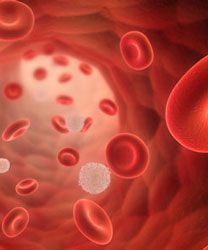Article
Serum Biomarkers Are Early Predictors for Haplo-SCT Outcomes
Author(s):
Higher levels of the serum biomarkers ST2 and REG3α were associated with increased incidence of graft-vs-host disease and increased risk for transplant-related mortality in patients who have undergone haploidentical stem-cell transplantation with post-transplant cyclophosphamide.

Higher levels of the serum biomarkers ST2 and REG3α were associated with increased incidence of graft-vs-host disease (GVHD) and increased risk for transplant-related mortality (TRM) in patients who have undergone haploidentical stem-cell transplantation with post-transplant cyclophosphamide (haplo-SCT).
At the 2020 Annual European Hematology Association Congress, Marta Fonseca-Santos, Hospital Universitario de Salamanca, Salamanca, Spain, presented data from an analysis of ST2 and REG3α levels after haplo-SCT.
Fonseca-Santos and her colleagues sought to determine if serum biomarker levels were associated with transplant-related mortality and graft-vs-host disease severity. This was a prospective study with 102 consecutive patients who underwent a haplo- SCT at the University Hospital of Salamanca between 2012 and 2019. The panel was analyzed in serial serum samples collected prospectively on days 0, 3, 7, 14 and 21 of haplo-SCT in 81 patients.
“When we analyze the role of these biomarkers, we find that higher levels of ST2 in the first week of transplantation were associated with a higher transplant-related mortality and graft-vs-host disease severity. This also happens when we analyze ST2 at day 14,” said Fonseca-Santos, who was lead author. “Also, when we analyze REG3a levels at days 7 and 14, higher levels were associated with a higher transplant-related mortality and graft-vs-host disease severity.”
At a median follow-up of 35 months, cumulative incidence of aGVHD IIb-IV was 61% on day 180 and 15% for aGVHD III-IV. At 2 years, incidence of moderate to severe chronic GVHD was 12.5%. Transplant-related mortality (TRM) was 14% at day 100 and 25% at 1 year. At 2 years, overall survival (OS) was 64% and progression-free survival (PFS) was 61%. The composite endpoint of GVHD-free relapse-free survival (RFS) at 2 years was 49%.
Investigators also found that elevated ST2 levels at day 7 were associated with poorer GVHD-free RFS (P = .01148) and OS (P 3.01E-05). Elevated ST2 levels at day 14 were associated with lower 2-year OS (P <.05), while elevated ST2 levels at days 7, 14, and 21 were associated with lower 2-year PFS.
Similarly, elevated REG3α levels at day 7 and day 14 (P = .01543) were associated with poorer GVHD-free RFS. The same was true for OS when REG3α levels were elevated at day 7 (P = .0067).
At day 7, elevated levels of ST2 (P <8.88E-4) and REG3α (P = .0139) were associated with greater TRM. Elevated ST2 levels at day 7 (P <.04) and REG3a levels at day 7 and at day 14 (P = .024) were associated with greater aGVHD severity. At day 14, elevated levels of ST2 levels (P <.05) and REG3α were associated with higher TRM at 1 year.
In multivariate analysis, elevated ST2 at day 7 (HR, 6.04; 95% CI; 1.31-27.81; P = .021) was an independent predictor for TRM as were previous autologous SCT (HR, 24.5; 95% CI, 1.75-336.96; P = .017), hematopoietic cell transplantation-specific comorbidity index greater than 3 (HR, 98.2; 95% CI, 11.12-866.47; P = .000), and CD34+ cell count greater than 4x106 (HR, 0.19; 95% CI, 0.04-0.92; P = .039). REG3α level was not a predictor for TRM at day 7 (HR, 4.19; 95% CI, 0.88-19.78; P = .070) but was at day 14 (HR, 4.65; 95% CI, 1.13-18.98; P = .032).
ST2 levels at days 7 and 14 and REG3α levels at day 14 were the only independent predictors for aGVHD severity. Furthermore, ST2 at day 7 (HR, 5.58; 95% CI, 1.09-28.57; P = .038) and at day 14 (HR, 25.50; 95% CI, 2.28-285.2; P = .008) were the only variables independently associated with OS.
ST2 and REG3a levels at day 14 were the only independent predictors for PFS and GVHD-free RFS.
“The results confirm the significant role of ST2 and REG3α in haplo-SCT outcome in the largest single center cohort to date of a homogenous series of haplo-SCT,” Fonseca-Santos said, adding that incorporation of biomarkers into classical risk variables in haplo-SCT appears promising. “They also demonstrate the prognosis impact as early as 7 and 14 days after infusion.”
Reference
- Fonseca-Santos M, Garcia-Alvarez M, Corchete-Sanchez LA, et al. Early measurement of st2 and reg3 has a predictive value in haploidentical transplantation with post-transplant cyclophosphamide outcome. Presented at: 2020 European Hematology Association Congress; July 11 to 21, 2020; Virtual. Abstract S258. bit.ly/2XXuzvi






%20(2)%201-Recovered-Recovered-Recovered-Recovered-Recovered.jpg?fit=crop&auto=format)

%20(2)%201-Recovered-Recovered-Recovered-Recovered-Recovered.jpg?fit=crop&auto=format)
%20(2)%201-Recovered-Recovered-Recovered-Recovered-Recovered.jpg?fit=crop&auto=format)